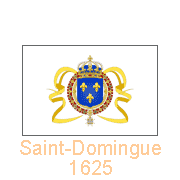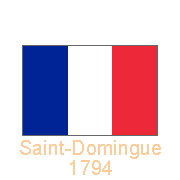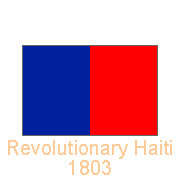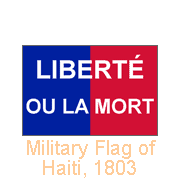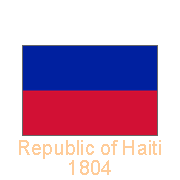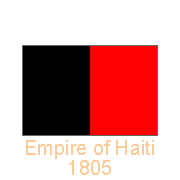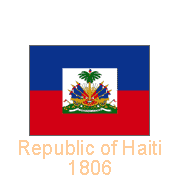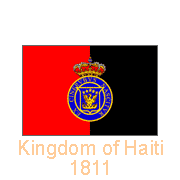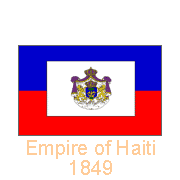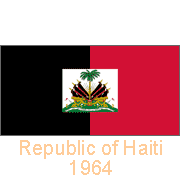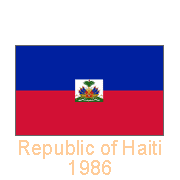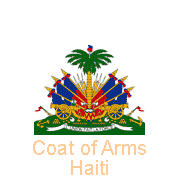A Flag history of Haiti
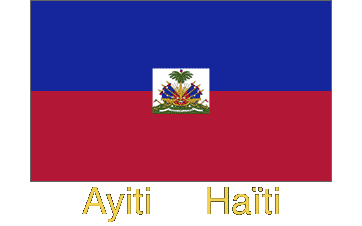
A Flag history of Haiti
When the Spanish and French colonial powers occupied and exploited the island of Hispaniola, they planted their imperial flags to indicate their possession. At the Treaty of Ryswick of 1697, which divided Hispaniola between the Spanish and French, France received the western third and subsequently named it Saint-Domingue. The French royal government used, among others, a blue shield and yellow fleur-de-lis on a white background, surmounted by a crown and surrounded by Royal insignia.
you may then send it as a postcard if you wish.
During the French Revolution in 1789, the colours red, white and blue were adopted. It was first a “cockade”, a knot of ribbons worn in the hair; the colours were those of the city of Paris with the Royal colour white, and this developed into the present “tricolour” flag that became official in 1794. In 1798 the black Haitian leader Toussaint L’Ouverture also adopted the French tricolour as his flag when nominally governor of the colony. After Toussaint L’Ouverture wrote a separatist constitution, the French invaded, kidnapped him and took him to France. In July 1802, the black people, led by Jean-Jacques Dessalines, revolted against the French and in February 1803, in Petite Rivière de l’Artibonite, Jean-Jacques Dessalines, chief of the black rebels, and Alexandre Pétion, leader of the mulattos, proclaimed Haiti’s independence. On 18 May 1803 at the Congress of Arcahaie, all the chiefs declared their loyalty to Dessalines, who tore up the French flag. He threw away the white stripe as a symbol of the whites and had the remaining stripes sewn together by Catherine Flon, the goddaughter of Jean-Jacques Dessalines, as the first Haitian flag. The inscription “Liberté ou la Mort” (Freedom or death) was added, and this was used as a military flag. On 1 January 1804, Independence Day, the flag was modified: this time, the blue and red bands were placed horizontally: this was the first flag of the independent Republic of Haiti.
On 8 October 1804 Dessalines was proclaimed Emperor of Haiti under the name of Jacques I. The blue band (placed vertically again) was changed to black on 20 May 1805; this can be interpreted as symbolising the people of the country, or the colours could represent the motto “Freedom (red) or Death (black)”. After Dessalines, who ruled as a despot, was assassinated, the country was divided: the Republic in the north, directed by Henri Christophe (1806 - 1820), retained this flag. General Pétion was proclaimed president of the south and western part of Haiti on 19 March 1807. Pétion changed his blue-red vertical flag back to the horizontal configuration of 1804. He added a white rectangle with the country’s arms: a Palm tree surmounted by the Phrygian liberty cap, flags and cannons and the motto “L’UNION FAIT LA FORCE” (Unity is Strength). This flag has endured throughout the 19th and 20th Centuries. There have been minor changes in the arms and the size of the white rectangle.
Henri Christophe, who was recognised in the north, northwest and Artibonite, had maintained the imperial black-red flag of Dessalines. He built the Citadelle Laferrière or Citadelle Henri Christophe, a large mountaintop fortress between 1805 and 1820, as part of a system of fortifications designed to keep the newly independent nation of Haiti safe from French incursions. On 28 March 1811, he was proclaimed King under the name of Henri I and changed the flag. It was red at the hoist and black at the fly. A shield with a phoenix under five five-pointed stars was in the centre, all in gold on a blue background. The shield bore a crown and the Latin inscription “Ex cinerebus nascitur” (From the ashes we will arise). In 1818 Pétion conquered the north, deposed Henri and re-imposed the blue and red flag. In 1847 Faustin Soulouque was elected president of Haiti but then proclaimed himself Emperor, as Faustin I (1849-1859), in a lavish ceremony inspired by Napoléon. In 1849 the coat of arms was replaced by imperial symbols. The Empire of Faustin I ended on 15 January 1859, when he was overthrown and sent into exile, and the Republic’s coat of arms was reintroduced.
Since then, Haiti has had a very chaotic history with coups, foreign intervention, and American occupation from 1915 to 1934. Then, in 1957, Dr François Duvalier (“Papa Doc”) became President of Haiti. In 1964 he made himself President for Life, and on 25 May 1964, the black and red flag of Dessalines was restored; it was officially readopted on 21 June 1964 as Haiti’s Civil flag (in proportions 1:2). The State or National Flag featured the coat of arms, with its flags also changed to the vertically divided black and red ones and no Phrygian Liberty cap above the palm tree. After Papa Doc died in 1971, he was succeeded by his son Jean-Claude Duvalier (“Baby Doc”). A popular uprising in 1986 led to his overthrow. On 25 February 1986, the people requested that the red-and-blue flag be reestablished. The constitution of 1987 confirmed the Civil flag as blue over red. The proportions were now 3:5, although sometimes flags with other proportions (like 3:4) were used. The original coat of arms was reintroduced but smaller: the rectangle’s width is one-fifth of the flag’s width. However, flags with much larger rectangles may be seen, so this does not seem to be a hard and fast rule.


